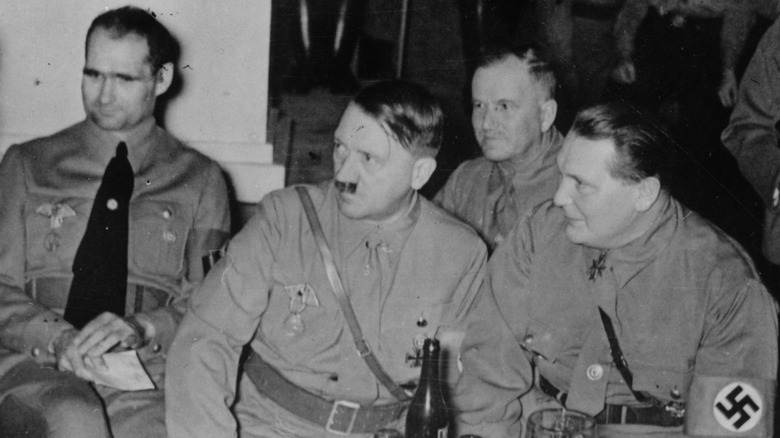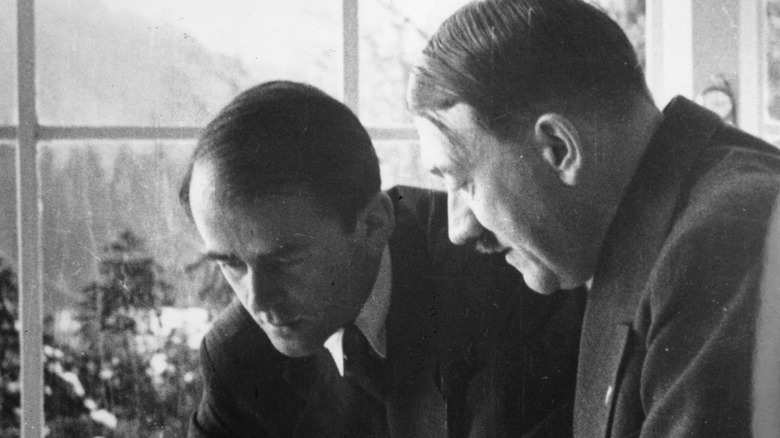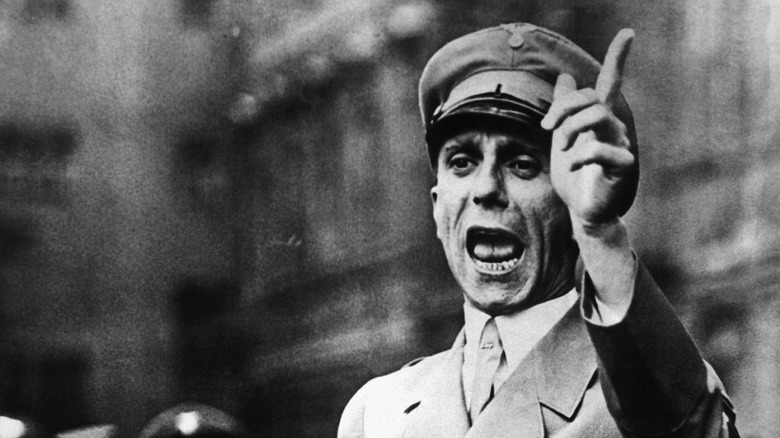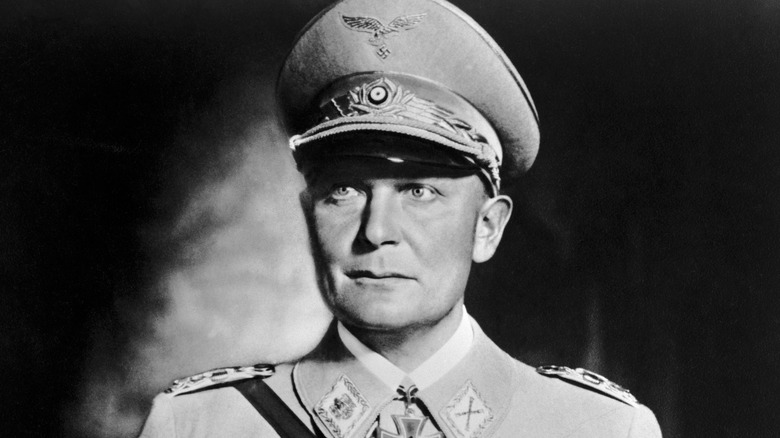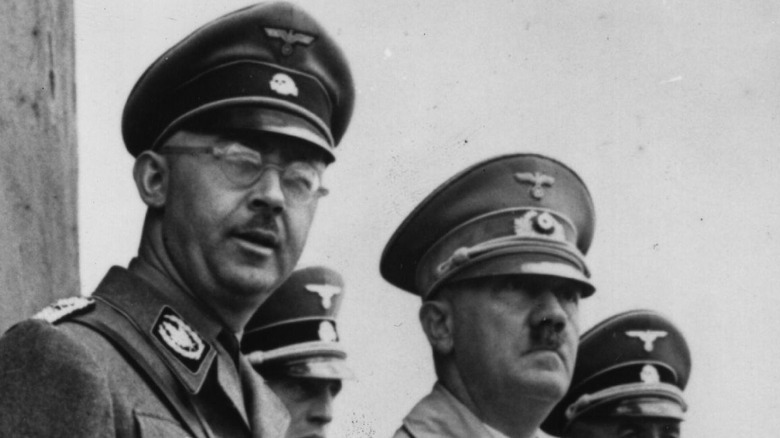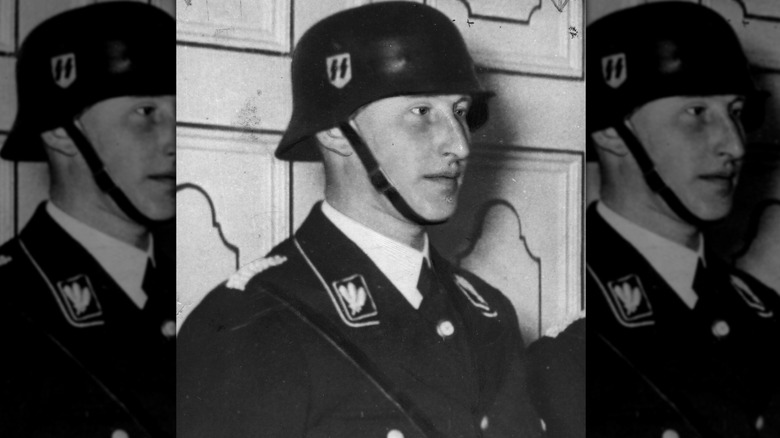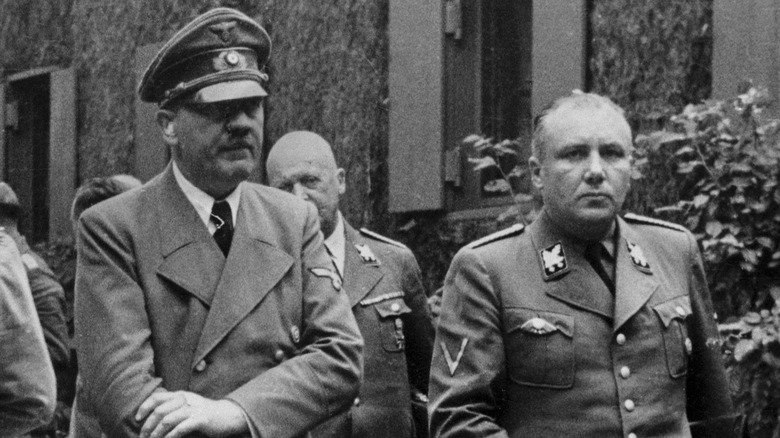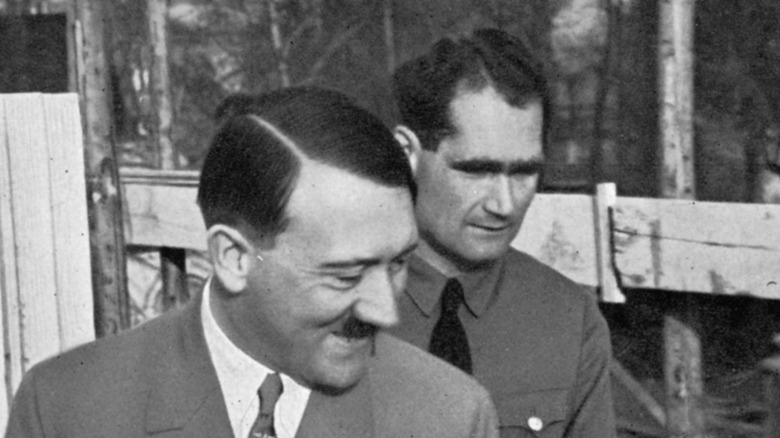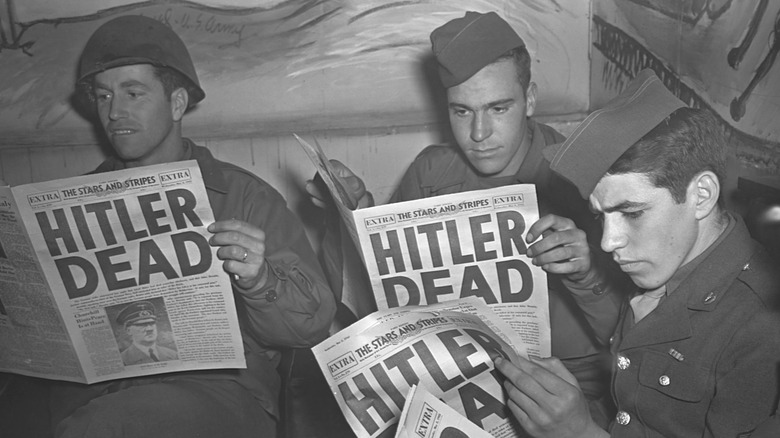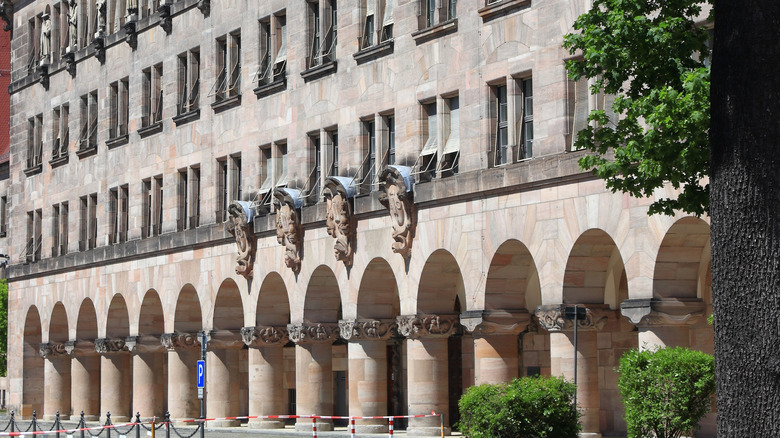The Disturbing Truth About Hitler's Inner Circle
On a February night in 1933 in Berlin, flames leaped from the roof of the parliament building called the Reichstag. Police captured the suspected arsonist, Marinus van der Lubbe, a Dutch communist. The newly appointed German Chancellor Adolf Hitler watched the flames and saw opportunity. According to an eye witness, Hitler shouted, "'There will be no mercy now. Anyone who stands in our way will be cut down" (via The German Historical Institute). The young politician from the Nazi party continued, "Everybody in league with the Communists must be arrested. There will no longer be any leniency for Social Democrats either."
Hitler made good on his word, using fire at the Reichstag to justify strict new laws. Within a month, Hitler had the power to enact laws without input from Parliament. He passed laws to limit free speech, outlaw other political parties, and assume dictatorship. As führer, he did not share power well. Yet even dictators don't work alone, and there were men Hitler depended upon and confided in. These included Rudolph Hess (pictured above, far right), who was deputy führer, and the reichsmarschall — the top army commander — Hermann Goering (pictured above, far left). Each man in Hitler's inner circle worked in different ways toward the dictator's focused goals of German expansion through war, and the genocide of the Jews through the Holocaust.
Albert Speer
Albert Speer was an architect by training, but as a Nazi official he was in charge of armaments. Speer doubled Germany's weapons production, even while under air attack from the Allies. To achieve what many described as an "armaments miracle," Speer used the assembly-line manufacturing techniques of American businessman Henry Ford, who himself had a dark side and was admired by Adolf Hitler for his beliefs. Spear also used the forced labor of millions who were enslaved in Germany's concentration camps.
Though he was close friends with Hitler due to a mutual interest in architecture, Speer lost faith in him towards the end of World War II. As it became clear that Germany would lose the war, Hitler announced the "Nero Decree" of 1945. The purpose: to destroy German infrastructure so it could not be used by the Allies. This was too much for the architect. Not only did Speer refuse to carry out the decree, but in early 1945, he also obtained poison gas from an armaments factory with the intention of assassinating Hitler in his bunker. As he testified years later in the Nuremberg Trials (via the Lillian Goldman Law Library), "various technical difficulties" prevented him from carrying out his plan.
Joseph Goebbels
Originally a failed novelist, Joseph Goebbels became adept in public relations once he joined the Nazi party. He wrote for the party newspaper Völkische Freiheit (Folkish Freedom) and was good at stirring up political agitation. A high-ranking party member, he would send the Nazi stormtroopers or SA (predecessors to the SS) into neighborhoods where he knew the people would resist their presence, and then publicize the fighting while celebrating the fallen soldiers as martyrs. These tactics earned Adolf Hitler's admiration, causing him to promote Goebbels to the position of minister for propaganda and public enlightenment in 1933, a post he held for twelve years.
Goebbels' job was to sway public opinion by controlling what Germans read and didn't read. While the official Nazi publisher churned out millions of copies of Hitler's memoir "Mein Kampf," Goebbels created a list of banned books that did not align with the views of the party. Speaking at one book burning at Humboldt University in 1933, he praised the "cleaning of the German spirit" (via the Holocaust Encyclopedia) by burning books written by Jews, foreigners, and pacifists. He used print, radio, and television to extol what he considered the German virtues of self-sacrifice and racial purity. On the other hand, he used the same media to denigrate Jews.
In a televised 1935 speech, Goebbels said that Jews were "subhuman" and bent on destroying western culture, and by 1938, Goebbels was sanctioning acts of violence against Jews. By the time violence in the form of genocide was organized by the party, the media had already paved the way for the public to accept it.
Hermann Göring
Having served as a pilot in World War I, Hermann Göring joined the Nazi party in 1922. With his military background he was appointed head of the SA and fought alongside Adolf Hitler in his unsuccessful coup d'etat, called the Beer Hall Putsch, in 1923. Shot and wounded in that battle, he developed a morphine addiction while receiving medical care in Austria, which he would deal with most of his life. Returning to Germany and still an avid supporter of Hitler, Göring used his high-society connections to help elect Hitler to Parliament. He was rewarded for his efforts: once Hitler was appointed chancellor, he in turn appointed Göring to the top political position of reichsminister.
Tasked with creating top-secret police known as the gestapo, Göring was later appointed head of the German air force in 1935, and held that position through the end of World War II. Though Hitler appointed Göring his successor as early as 1939, he took it back and stripped Göring of all his titles when he tried to assume power too early in 1945.
Heinrich Himmler
Heinrich Himmler was still a university student when he first began reading racist propaganda. Embracing the ideology of racial supremacy, Himmler became a Nazi party member soon after his graduation in 1923. He left his job at a manure factory and found work as a secretary for Nazi propagandist Gregor Strasser. Himmler caught Adolf Hitler's attention and rose in the ranks to become head of the SS, the Nazi party's political army. Under his leadership, the SS swelled to over 50,000 members by the time Hitler took power in 1933.
Himmler espoused theories that were unusual even by Nazi standards, like how Germans could be traced back genetically to Atlanteans. To prove this and other theories, he assembled an elite team of archaeologists called the Ahnenerbe. An efficient bureaucrat, he impressed Hitler with his management of the first concentration camp at Dachau, and eventually assumed control over all of Germany's concentration camps, which during the height of the war totaled 40 main camps with hundreds of subcamps. And so, Himmler became the architect of the Holocaust, which killed 6 million people.
Reinhard Heydrich
Reinhard Heydrich was Heinrich Himmler's protege. The son of an opera singer, he was trained as a violinist, but along the way developed an interest in a growing racist nationalist movement rising in Germany towards the end of World War I. Inspired by military demonstrations, he decided to enlist in the army after high school rather than pursue a music career.
Meeting Himmler in 1931, he soon became head of the intelligence faction of the SS, known as the SD, and the gestapo, or secret police. He was in charge of investigating and incarcerating all the enemies of the Nazi party, including communists, freemasons, and Jews. On Kristallnacht (the Night of Broken Glass), which took place overnight between November 9 and 10, 1938, Heydrich ordered the gestapo to arrest thousands of Jews, who were then incarcerated in concentration camps.
This was only the beginning of a plan that Heydrich championed, called the "solution to the Jewish question": the annihilation of 11 million Jews across Europe, which Heydrich promoted at the Wannsee Conference in 1942.
Martin Bormann
Martin Bormann (pictured above, right) was Adolf Hitler's private secretary. Not making headlines but working behind the scenes to make things happen, Bormann's signature appeared on key documents that included orders to deport Jews. He also played a role in the Euthanasia Program, which killed adults and children with disabilities, considered by Nazis to be a burden on the state.
Through mundane tasks, Bormann was able to exercise power over Hitler. He created the "Adolf Hitler Fund for German Business" to raise official funding, and also handled Hitler's private assets. He gave Hitler a German shepherd named Blondi, who became a constant companion. He oversaw the renovations of Hitler's mountain retreat in Obersalzberg and then moved to a nearby house within view of the estate. By monitoring the comings and goings, Bormann became Hitler's unofficial gatekeeper. He also kept Hitler's appointment calendar, which he deftly used to limit Hitler's time spent with other members of the inner circle whom Bormann considered rivals, including Albert Speer, Joseph Goebbels, and Heinrich Himmler.
Rudolph Hess
Rudolph Hess first heard Adolf Hitler speak in 1920 and became a devoted follower. Arrested along with Hitler in 1923 during the Beer Hall Putsch, he became Hitler's confidante in Landsberg prison. Hess transcribed as Hitler dictated his memories, grievances, and prejudices, thereby creating an early draft of "Mein Kampf." After Hitler took power, Hess was named deputy führer, a figurehead position, but his reliance on astrology and interest in telekinesis caused him to lose respect in Nazi circles.
Though devoted to Hitler and Germany, Hess was worried about Hitler's plan to invade the Soviet Union while still fighting France and Great Britain. He also attempted to negotiate Britain's surrender on his own, in secret. A pilot, Hess flew a single-engine bomber plane to Scotland in 1941, aiming for the residence of the Duke of Hamilton, whom he mistakenly believed would be open to negotiating with the Nazis. However, Hess lost his way and ran out of gas. Parachuting out of his plane before it crash-landed on a Scottish farm, he was captured and held as a prisoner in Britain, with some of that time in the Tower of London. Hitler, upon hearing the news of Hess' aborted mission and subsequent capture, stripped him of all titles and left him to serve his time as a prisoner of war.
The circle dissolves
In April 1945, as Russian troops approached Berlin, Adolf Hitler was living in his bunker under the city and was surrounded by his closest allies. It was there that Hitler married his long-time mistress Eva Braun on April 29, and the two of them died by suicide a day later to avoid capture by the Russians.
Reinhard Heydrich was the only member of the inner circle to die before Hitler. After surviving an assassination attempt in Prague in 1942, he died of his injuries a few months later. Hermann Göring, Heinrich Himmler, and Rudolph Hess, having been previously stripped of their titles, were all prisoners — Göring and Himmler under house arrest, and Hess as a prisoner of war — when Hitler died. Albert Speer was absent from the bunker and was later captured in the northern German city of Flensburg by the Americans.
Martin Bormann and Joseph Goebbels were with Hitler in the bunker until his death. Bormann stayed long enough to settle Hitler's affairs, then disappeared, but Goebbels' story is particularly harrowing: together he and his wife Magda poisoned their six children with cyanide, before the couple died by suicide.
Nuremberg Trials
Following the war, the International Military Tribunal held trials for Nazi leaders in Nuremberg, Germany, to try them for war crimes, crimes against peace, and crimes against humanity. Hermann Göring was found guilty on all counts and sentenced to death at Nuremberg. The court denied his request to be executed by firing squad, so he died by suicide to avoid hanging. Martin Bormann was found guilty in absentia, and his body was later found in 1972, the cause of death undetermined but with circumstantial evidence suggesting death by suicide. Rudolph Hess survived prison in England to be transferred to Nuremberg, where he was sentenced to life in prison, but also died by suicide.
Testifying at Nuremberg, Albert Speer claimed to know nothing of Adolf Hitler's plans for the Holocaust. He was sentenced to only 20 years in prison for crimes against humanity, and afterward retired to England, where he wrote books and was known as "the good Nazi." However, a letter surfaced after his death to prove his claim was a lie. "There is no doubt — I was present as Himmler announced on October 6, 1943 that all Jews would be killed," wrote Speer in a letter (via The Guardian) to author Helene Jeanty in 1971. "Who would believe me that I suppressed this, that it would have been easier to have written all of this in my memoirs?"
